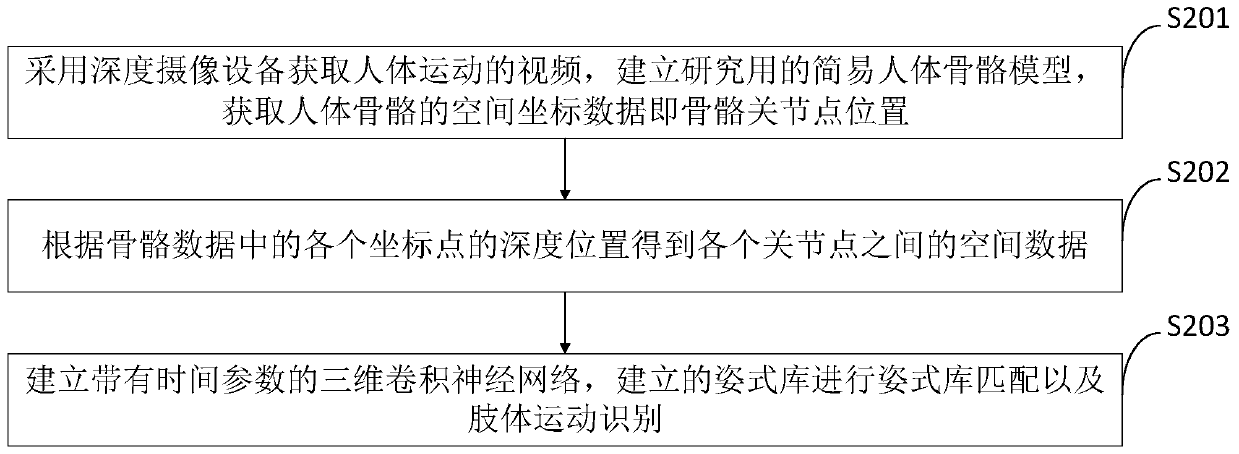Human body action function detection system, detection method and detector
A function detection and human motion technology, applied in the field of human body data recognition, can solve the problems of time-consuming, high cost of motion capture system, and high economic cost
- Summary
- Abstract
- Description
- Claims
- Application Information
AI Technical Summary
Problems solved by technology
Method used
Image
Examples
Embodiment 1
[0188] There are many kinds of human body movements, which can be roughly divided into five basic forms: moving, jumping, balancing, rotating and swinging. There are single and simple movements such as standing, squatting and jumping, as well as dancing, basketball, eating and so on. More complex actions of human interaction. According to the complexity of human body movements, human limb movements can be divided into three categories: motor units, body movements and human activities from simple to complex.
[0189] (1) Motion unit
[0190] Motor unit is the most basic unit used to describe body movement. It represents the most intuitive body behavior during human movement, such as the most basic body movements such as "raising the head", "putting down the left hand", and "bending".
[0191] (2) Body movements
[0192] Body movements are composed of multiple movement units. Human body movements with certain meanings, such as "leg raising" and "arm swinging" can form the acti...
Embodiment 2
[0237] The "four-character test" is an inspection method used to judge sacroiliac joint lesions. During the test, the subject sat on the measurement chair, faced the camera, looked straight ahead, and placed the lateral ankle of the lower limb of the affected side on the knee joint of the healthy side.
[0238] Subtract the coordinates of the right knee joint point from the coordinates of the left knee joint point to obtain the three-dimensional vector A in the camera coordinate system. The distance of the calculated vector A on the Y axis is the vertical distance between the two knees.
[0239] Measurement formula:
[0240] Set the coordinates of the left knee joint point as (X 13 ,Y 13 ,Z 13 ), the coordinates of the right knee joint point are (X 17 ,Y 17 ,Z 17 ),Calculated as follows:
[0241] Vertical distance between two knees d=|Y 13 -Y 13 |.
Embodiment 3
[0243] "Neck flexion" is used to measure the range of motion of the frontal forward flexion of the neck joints. During the test, the subject stood on the measurement table, faced the camera, looked straight ahead with his eyes, and retracted his jaw when standing still. The subject tried to stretch his neck forward to the maximum angle and then the system read it.
[0244] Subtract the neck joint point coordinates from the head joint point coordinates to obtain a three-dimensional vector A in the camera coordinate system. Project A into the Y-Z plane of the camera coordinate system to obtain a two-dimensional vector B. The angle between the calculated vector B and the Y axis is the angle at which the head protrudes.
[0245] Set the coordinates of the head joint point as (X 3 ,Y 3 ,Z 3 ), the coordinates of the neck joint point are (X 2 ,Y 2 ,Z 2 ), so the three-dimensional vector A is equal to (X 3 -X 2 ,Y 3 -Y 2 ,Z 3 -Z 2 ), the two-dimensional vector B is equal...
PUM
 Login to View More
Login to View More Abstract
Description
Claims
Application Information
 Login to View More
Login to View More - R&D
- Intellectual Property
- Life Sciences
- Materials
- Tech Scout
- Unparalleled Data Quality
- Higher Quality Content
- 60% Fewer Hallucinations
Browse by: Latest US Patents, China's latest patents, Technical Efficacy Thesaurus, Application Domain, Technology Topic, Popular Technical Reports.
© 2025 PatSnap. All rights reserved.Legal|Privacy policy|Modern Slavery Act Transparency Statement|Sitemap|About US| Contact US: help@patsnap.com



